- Details
- Written by: Elmazen
- Category: Flags of Countries of the World
- Hits: 724
Flag of Jamaica, Currency, Population, Tourist Places
Exploring Jamaica: A Comprehensive Guide to the Island Nation
Jamaica is a beautiful island nation in the Caribbean known for its stunning landscapes, vibrant culture, and rich history.
From its warm, tropical beaches to its lively reggae music, Jamaica offers an unforgettable experience for visitors.
Let’s dive into some key facts and highlights of this remarkable country.
Flag of Jamaica
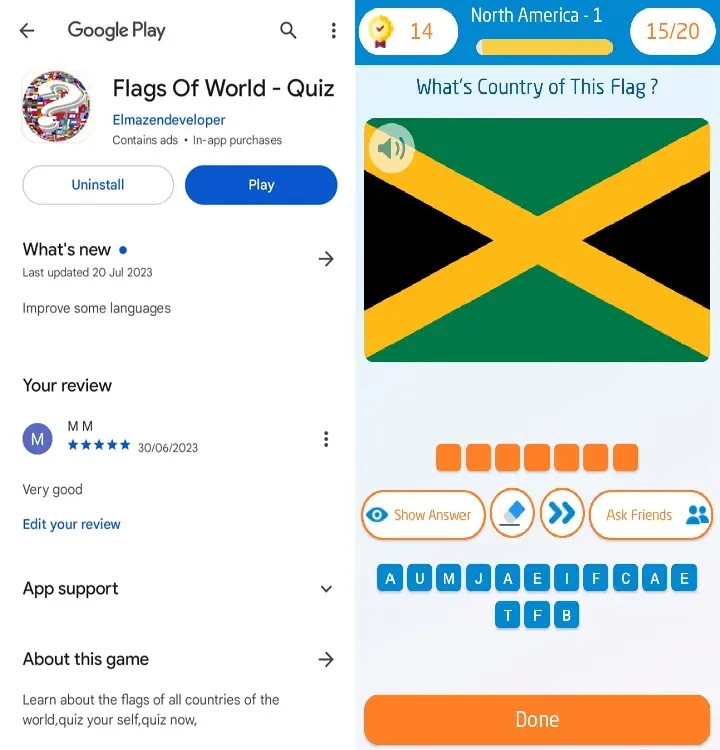
Download the application  Flags Of World - Quiz ,
Flags Of World - Quiz ,
And test your knowledge with Flags of World ,
1. Population of Jamaica:
As of November 2024, Jamaica has a population of approximately **2.8 million people**.
The majority of Jamaicans live in urban areas, with Kingston, the capital city, being the largest and most populous area.
Jamaica is known for its friendly and hospitable people, who contribute to the rich cultural heritage of the island.
2. Jamaica's Flag and Its Meaning:
The Jamaican flag is composed of three colors: **black, green, and gold**.
It features a unique design with a diagonal cross dividing the flag into four triangles, with the top and bottom triangles in green, and the left and right triangles in black.
Each color has a symbolic meaning:
Black: represents the strength and creativity of the Jamaican people.
Green: symbolizes the lush vegetation and natural beauty of the land.
Gold: stands for the country's abundant sunshine and natural wealth.
The Jamaican flag is a proud emblem of national identity and resilience, reminding Jamaicans of their rich culture and determination.
3. Jamaica's Currency:
The official currency of Jamaica is the **Jamaican Dollar (JMD)**.
It is symbolized by the "$" sign, but sometimes written as "J$" to distinguish it from other dollar currencies.
Jamaican dollars come in various denominations and are used for all transactions on the island.
Flag of Jamaica

Download the application  Flags Of World - Quiz ,
Flags Of World - Quiz ,
And test your knowledge with Flags of World ,
4. Jamaica's Borders:
Jamaica is an **island nation** in the Caribbean Sea and does not share land borders with any other country.
It is situated about 145 kilometers (90 miles) south of Cuba, and 160 kilometers (99 miles) west of Haiti on the island of Hispaniola.
Surrounded entirely by water, Jamaica's coastal areas are famous for their beaches, marine life, and spectacular views.
5. Culture of Jamaica:
Jamaican culture is a vibrant blend of African, European, and indigenous influences, creating a unique cultural identity that is world-renowned.
Key elements of Jamaican culture include:
Music: Jamaica is the birthplace of reggae music, a genre that emerged in the 1960s and is often associated with legendary musician Bob Marley.
The island has also produced other music styles like ska, dancehall, and dub, which have influenced global music trends.
Cuisine: Jamaican food is known for its bold flavors and use of spices.
Signature dishes include jerk chicken, ackee and saltfish, curried goat, and rice and peas.
Jamaican cuisine combines African, Spanish, and indigenous Taino influences, using local ingredients such as plantains, yams, and coconut.
Language: While English is the official language, many Jamaicans speak Patois (or Patwa), a Creole language with African, English, and Spanish influences.
Patois is often heard in everyday conversation and Jamaican music, giving the culture a distinctive linguistic flair.
Festivals: Jamaicans celebrate many vibrant festivals, including Reggae Sumfest, Jamaica Carnival, and Independence Day, each showcasing music, dance, and traditional foods.
6. Best Places to Visit in Jamaica:
Jamaica offers an array of scenic spots and attractions that draw visitors from all over the world.
Here are some of the best places to visit:
Montego Bay: Known for its stunning beaches, resorts, and the famous Doctor’s Cave Beach, Montego Bay is a popular spot for tourists.
Visitors can also enjoy snorkeling and shopping along the "Hip Strip".
Negril: Famous for its Seven Mile Beach and breathtaking sunsets, Negril is a laid-back beach town that offers water sports, cliff diving, and a range of beachside bars and restaurants.
Ocho Rios: A must-visit for nature lovers, Ocho Rios is home to Dunn’s River Falls, a beautiful waterfall that visitors can climb.
The town also offers activities like river rafting, zip-lining, and visiting the scenic Fern Gully.
Kingston: The capital city is the cultural heart of Jamaica, where you can visit the Bob Marley Museum, explore Emancipation Park, and experience the local nightlife.
Kingston also hosts many music festivals and cultural events.
Blue Mountains: Known for producing world-famous Blue Mountain coffee, this mountain range offers hiking trails, stunning views, and tours of coffee plantations.
Port Antonio: Less crowded than other tourist areas, Port Antonio offers a blend of beaches, rivers, and lush vegetation.
Highlights include the Blue Lagoon, Frenchman’s Cove, and rafting on the Rio Grande.
From its colorful culture to its diverse natural beauty, Jamaica is a destination that captivates visitors and leaves them with unforgettable memories.
Whether you're looking to relax on the beach, explore lush landscapes, or immerse yourself in the rhythm of reggae, Jamaica has something for everyone.
Flag of Jamaica

Download the application  Flags Of World - Quiz ,
Flags Of World - Quiz ,
And test your knowledge with Flags of World ,
- Details
- Written by: Elmazen
- Category: Flags of Countries of the World
- Hits: 733
Flag of Honduras, Currency, Population, Tourist Places
Honduras: A Guide to Population, Flag, Currency, Borders, Culture, and Top Places to Visit
Honduras is a beautiful and vibrant Central American country known for its natural landscapes, rich cultural heritage, and friendly people.
If you’re curious about Honduras, here’s an informative guide covering its population, flag, currency, borders, culture, and top tourist destinations.
Flag of Honduras
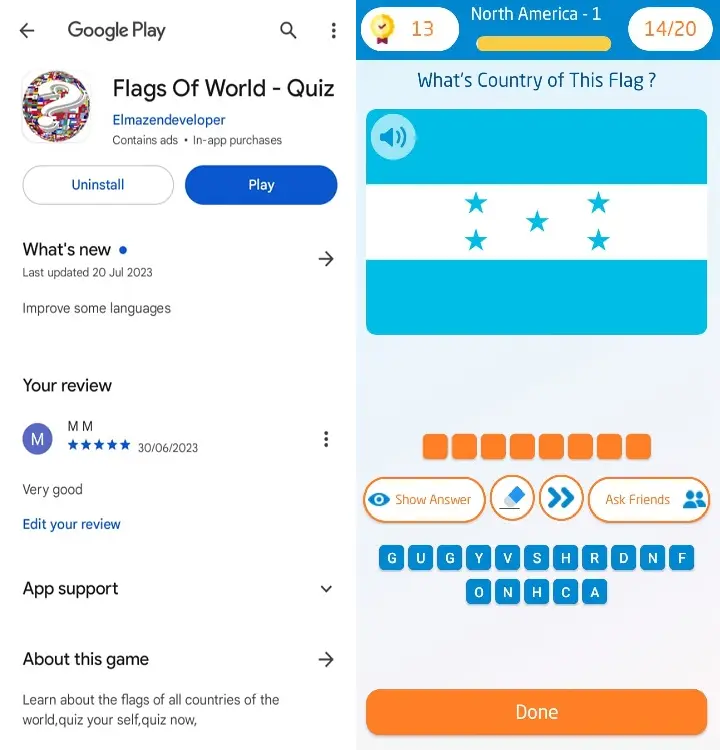
Download the application  Flags Of World - Quiz ,
Flags Of World - Quiz ,
And test your knowledge with Flags of World ,
1. Population of Honduras:
Honduras has a population of approximately **10.88 million people** as of November 2024.
The population is primarily young, with a significant proportion under the age of 30.
Honduras is known for its diverse ethnic mix, including Mestizo (a combination of Indigenous and Spanish ancestry), as well as small communities of Indigenous groups such as the Lenca, Miskito, Garífuna, and Tawahka, each contributing to the country’s unique cultural tapestry.
2. The Honduras Flag and Its Meaning:
The **flag of Honduras** features three horizontal bands: the top and bottom bands are **blue**, while the middle band is **white** with five blue stars arranged in an "X" pattern in the center.
Blue bands: Represent the Caribbean Sea and the Pacific Ocean that border the country on each side.
White band: Symbolizes peace and prosperity.
Five blue stars: Represent the five nations of the former Federal Republic of Central America-Honduras, Guatemala, El Salvador, Nicaragua, and Costa Rica.
The arrangement signifies Honduras' hope for the unity of Central America.
3. Currency of Honduras:
The **currency of Honduras** is the **Honduran Lempira (HNL)**.
Named after an Indigenous leader, Lempira, who resisted Spanish colonization in the 16th century, this currency is used in daily transactions throughout the country.
The Lempira symbol (L) is commonly used to represent the currency.
Flag of Honduras

Download the application  Flags Of World - Quiz ,
Flags Of World - Quiz ,
And test your knowledge with Flags of World ,
4. Borders of Honduras:
Honduras shares land borders with **three countries**:
Guatemala: to the west,
El Salvador to the southwest,
Nicaragua to the southeast.
Additionally, Honduras has extensive coastlines along the **Caribbean Sea** to the north and a shorter coast on the **Pacific Ocean** to the south.
5. Culture of Honduras:
The culture of Honduras is a blend of **Indigenous, Spanish, and African influences**, which can be seen in the country’s language, music, dance, and cuisine.
Spanish is the official language, but several Indigenous languages are also spoken.
The Garífuna, an Afro-Indigenous group along the northern coast, are known for their unique music and dance traditions.
Music and Dance: Punta, a traditional dance and music style of the Garífuna, is very popular, along with merengue, salsa, and reggaeton.
Cuisine: Honduran food reflects the country’s agricultural diversity.
Staple dishes include **baleadas** (flour tortillas filled with beans, cheese, and sometimes meat), **tamales**, and **plato típico** (a meal with grilled meat, fried plantains, beans, and rice).
Tropical fruits like bananas, mangoes, and pineapples are also popular.
Festivals: Honduras celebrates many traditional festivals, such as the **Feria Juniana** in San Pedro Sula, which includes parades, concerts, and carnivals, and **Semana Santa** (Holy Week), a religious celebration observed throughout the country.
6. Best Places to Visit in Honduras:
Honduras boasts breathtaking natural beauty, fascinating archaeological sites, and vibrant cities.
Here are some must-visit places:
Roatán Island: Known for its stunning beaches, coral reefs, and diving spots, Roatán is part of the Bay Islands in the Caribbean Sea and attracts tourists seeking marine adventures and relaxation.
Copán Ruins: A UNESCO World Heritage site, Copán is an ancient Maya city with impressive stone carvings, hieroglyphic staircases, and ceremonial sites, offering a glimpse into the rich history of the Maya civilization.
La Tigra National Park: Located near the capital, Tegucigalpa, this cloud forest park offers beautiful hiking trails, rich biodiversity, and a chance to see rare wildlife like jaguars and quetzal birds.
Pico Bonito National Park: This national park near La Ceiba has lush forests, waterfalls, and challenging hiking trails, making it popular for ecotourism and nature enthusiasts.
Lake Yojoa: Honduras’s largest natural lake, Lake Yojoa is surrounded by mountains, waterfalls, and caves.
It’s a peaceful spot for bird-watching, fishing, and exploring nearby coffee plantations.
Utila: Another Bay Island, Utila is known for its laid-back vibe and is one of the most affordable places in the world to get scuba certified.
Conclusion:
Honduras is a country filled with natural wonders, rich traditions, and welcoming communities.
Whether you’re interested in history, nature, or simply relaxing on a beautiful beach, Honduras offers a wide range of experiences for travelers.
Its unique blend of cultural influences and stunning landscapes makes it a destination worth exploring.
Flag of Honduras

Download the application  Flags Of World - Quiz ,
Flags Of World - Quiz ,
And test your knowledge with Flags of World ,
- Details
- Written by: Elmazen
- Category: Flags of Countries of the World
- Hits: 716
Flag of Haiti, Currency, Population, Tourist Places
Exploring Haiti: Population, Flag, Currency, Borders, Culture, and Best Places to Visit
Haiti is a unique Caribbean nation with a rich history, vibrant culture, and resilient spirit.
Here's a breakdown of some key aspects that define this fascinating country.
Flag of Haiti, Meaning
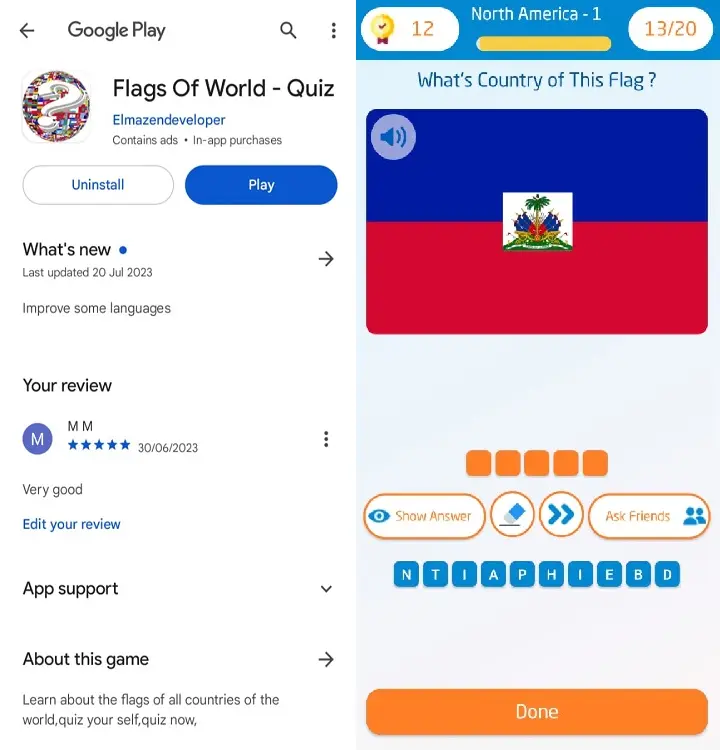
Download the application  Flags Of World - Quiz ,
Flags Of World - Quiz ,
And test your knowledge with Flags of World ,
1. Population of Haiti:
Haiti’s population is approximately 11.8 million as of November 2024, making it one of the most densely populated countries in the Caribbean.
The capital and largest city, Port-au-Prince, holds a significant portion of the population.
The country has a young demographic, with a large percentage under the age of 25.
2. Haiti’s Flag and Its Meaning:
The Haitian flag consists of two horizontal bands of blue and red with a white rectangle in the center featuring the country’s coat of arms.
The coat of arms includes a palm tree, cannons, and a banner with the motto "L'Union Fait La Force" ("Unity Makes Strength").
Blue: Represents the African heritage of the Haitian people.
Red: Symbolizes the European influence in the nation.
Coat of Arms: Highlights Haiti's determination for freedom, depicting symbols of strength and independence.
3. Haiti’s Currency:
The official currency of Haiti is the **Haitian gourde** (HTG), named after a common squash used in early trade.
Although the gourde is the official currency, prices are also often quoted in a currency called the **Haitian dollar**, a term used locally that represents five gourdes.
Flag of Haiti, Meaning

Download the application  Flags Of World - Quiz ,
Flags Of World - Quiz ,
And test your knowledge with Flags of World ,
4. Borders of Haiti:
Haiti occupies the western third of the island of Hispaniola, sharing it with the Dominican Republic to the east.
The country’s location provides it with access to the Caribbean Sea to the south and the Atlantic Ocean to the north, giving Haiti stunning coastlines on both sides.
It is also relatively close to Cuba and Jamaica.
5. The Culture of Haiti:
Haiti boasts a rich, unique culture shaped by African, French, and indigenous Taíno influences.
This blend is especially apparent in Haitian Creole, the widely spoken language alongside French, and in the country’s vibrant music, dance, and art.
Music and Dance: Kompa and rara music are popular, blending African rhythms with local flair.
Vodou ceremonies also feature traditional drumming, dancing, and singing.
Art and Literature: Haiti is known for its colorful and symbolic art, often depicting local life, nature, and spiritual themes.
Haitian literature includes notable writers like Jean Price-Mars and Jacques Roumain, whose works explore the country's history and struggles.
Cuisine: Haitian cuisine is flavorful, with dishes like griot (fried pork), rice and beans, and bouillon (a hearty meat and vegetable stew).
Spices and fresh herbs are essential components, reflecting both African and French influences.
Religious Influence: Vodou and Catholicism play significant roles in Haitian life, with many Haitians practicing a blend of both religions.
6. Best Places to Visit in Haiti:
Haiti offers a variety of beautiful and historic sites for travelers to explore.
Here are some highlights:
Citadelle Laferrière: A UNESCO World Heritage Site, this massive fortress is a symbol of Haiti's fight for independence.
Labadee: A beautiful beach area leased to Royal Caribbean, offering white sands and crystal-clear waters.
Jacmel: Known for its vibrant carnival celebrations, colonial architecture, and local arts, Jacmel is a cultural hub.
Bassin Bleu: A stunning series of natural waterfalls and pools, perfect for swimming and relaxation.
Île-à-Vache: An idyllic island known for its pristine beaches and turquoise waters, popular among those looking for a peaceful escape.
Saut-d'Eau: A waterfall and pilgrimage site where both Catholics and Vodou practitioners come for blessings.
In summary, Haiti’s distinct history, vibrant culture, and natural beauty make it an unforgettable destination.
From exploring historic sites like the Citadelle to enjoying the stunning beaches of Île-à-Vache, Haiti offers something special for every traveler.
Flag of Haiti, Meaning

Download the application  Flags Of World - Quiz ,
Flags Of World - Quiz ,
And test your knowledge with Flags of World ,
- Details
- Written by: Elmazen
- Category: Flags of Countries of the World
- Hits: 660
Flag of Guatemala, Currency, Population, Tourist Places
Exploring Guatemala: Population, Flag, Currency, Borders, Culture, and Top Attractions
Guatemala is a beautiful country located in Central America, known for its rich cultural heritage, vibrant landscapes, and historical significance.
If you're interested in learning about this fascinating country, here’s a look at some key facts, including population, flag symbolism, currency, borders, culture, and the best places to visit.
Flag of Guatemala, meaning
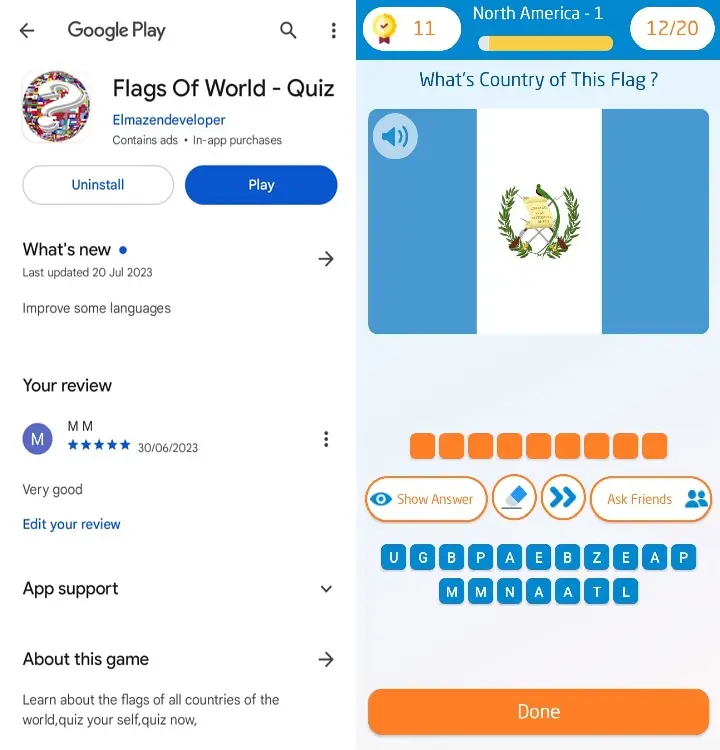
Download the application  Flags Of World - Quiz ,
Flags Of World - Quiz ,
And test your knowledge with Flags of World ,
1. Population of Guatemala:
As of November 2024, Guatemala has a population of approximately 18.5 million people, making it the most populous country in Central America.
The population is diverse, with a significant portion identifying as Indigenous, primarily of Maya descent, and others of mixed European and Indigenous ancestry (Mestizo).
Guatemala’s population is young, with a high percentage under the age of 30, which contributes to the country’s energetic and dynamic cultural environment.
2. Meaning of the Guatemalan Flag:
The Guatemalan flag consists of three vertical stripes: two light blue ones on the sides and a white stripe in the middle.
The blue stripes represent the two oceans that border Guatemala, the Pacific Ocean and the Caribbean Sea.
The white stripe symbolizes peace and purity.
At the center of the flag, the national emblem features a resplendent quetzal, the country’s national bird, which symbolizes freedom.
The emblem also includes a scroll with the date of Guatemala's independence (September 15, 1821), crossed rifles representing the country’s willingness to defend its freedom, and olive branches as a symbol of peace.
3. Currency of Guatemala:
The official currency of Guatemala is the Guatemalan quetzal, abbreviated as GTQ.
The quetzal was named after the resplendent quetzal, a bird that is not only a national symbol of freedom but also a highly revered creature in Mayan mythology.
The currency is subdivided into 100 centavos, and the quetzal is used in everyday transactions across the country.
Flag of Guatemala, meaning

Download the application  Flags Of World - Quiz ,
Flags Of World - Quiz ,
And test your knowledge with Flags of World ,
4. Borders of Guatemala:
Guatemala shares borders with four countries and two bodies of water:
North and West: Mexico,
Southeast: El Salvador,
South Coastline: Pacific Ocean,
East Coastline: A small stretch along the Caribbean Sea,
These borders make Guatemala a crossroads of Central American culture and trade, and its proximity to the Caribbean and Pacific waters shapes its climate and economy.
5. Culture of Guatemala:
Guatemala’s culture is a vibrant blend of ancient Mayan traditions and Spanish influences.
More than 20 Indigenous languages are spoken in addition to Spanish, the official language.
This linguistic diversity reflects Guatemala’s rich Indigenous heritage, particularly among Maya communities, who continue to celebrate age-old traditions, textiles, and customs.
Traditional Mayan clothing is colorful and intricate, often woven by hand and decorated with symbols representing nature and community.
Guatemalan cuisine is another cultural highlight, featuring staples like corn, beans, rice, and a variety of spices.
Some famous dishes include *pepian* (a spicy meat stew), *jocon* (a green sauce made with tomatillo), and *tamales*.
Guatemala is also known for its religious festivals and vibrant celebrations, such as Semana Santa (Holy Week), which features elaborate processions, and Dia de los Muertos (Day of the Dead), where locals honor deceased loved ones with unique customs.
6. Best Places to Visit in Guatemala:
Guatemala offers numerous attractions, from ancient ruins to beautiful natural landscapes.
Here are some top destinations:
Tikal National Park : Located in the heart of the jungle, Tikal is a UNESCO World Heritage site and one of the most famous Mayan ruins in Central America.
Visitors can explore ancient temples, pyramids, and palaces set amid lush rainforests.
Antigua Guatemala : This charming city is known for its Spanish architecture, cobblestone streets, and views of surrounding volcanoes.
Antigua is a UNESCO World Heritage site and a popular spot for festivals, culture, and history.
Lake Atitlán : Surrounded by volcanoes and traditional Mayan villages, Lake Atitlán is often described as one of the most beautiful lakes in the world.
Visitors can enjoy boat rides, hiking, and learning about local traditions from the Indigenous communities that live around the lake.
Semuc Champey : This natural limestone bridge, with turquoise pools formed by cascading waterfalls, is a hidden gem in the Guatemalan jungle.
It’s a popular destination for swimming, cave exploration, and admiring stunning landscapes.
Chichicastenango Market : Known as one of the largest Indigenous markets in Central America, this vibrant marketplace offers a variety of handmade crafts, textiles, fresh produce, and unique cultural items.
Pacaya Volcano : For the adventurous, hiking Pacaya Volcano offers a chance to witness active volcanic activity and incredible views.
Visitors can also roast marshmallows over hot lava flows!
Conclusion:
Guatemala is a captivating country, rich in history, natural beauty, and cultural diversity.
From exploring ancient ruins to experiencing vibrant traditions and breathtaking landscapes, there is much to discover in this Central American gem.
Whether you're interested in adventure, culture, or relaxation, Guatemala has something unique to offer for every traveler.
Flag of Guatemala, meaning

Download the application  Flags Of World - Quiz ,
Flags Of World - Quiz ,
And test your knowledge with Flags of World ,
- Details
- Written by: Elmazen
- Category: Flags of Countries of the World
- Hits: 734
Flag of Grenada, Currency, Population, Tourist Places
Grenada, known as the “Spice Isle” for its abundant nutmeg and spice production, is a beautiful Caribbean nation with a rich culture, stunning landscapes, and vibrant history.
Here’s an overview of Grenada covering its population, flag, currency, borders, cultural highlights, and top places to visit:
Flag of Grenada and it's meaning
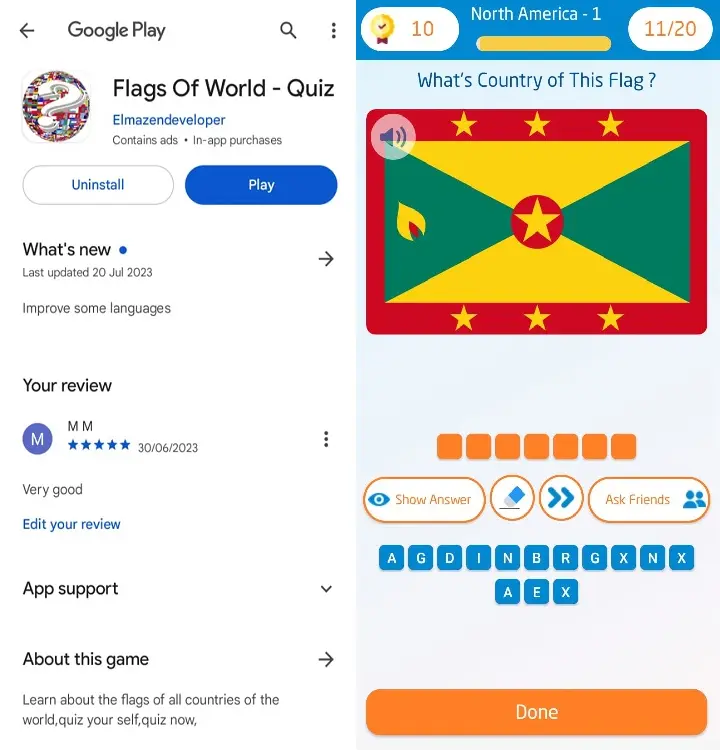
Download the application  Flags Of World - Quiz ,
Flags Of World - Quiz ,
And test your knowledge with Flags of World ,
1. Population of Grenada:
As of November2024, Grenada has a population of approximately **117,000** people.
The population is spread across the main island of Grenada and the smaller Grenadine islands of Carriacou and Petite Martinique.
The capital city, **St. George's**, is the most populous and serves as the country’s economic and cultural hub.
2. Grenada’s Flag and Its Meaning:
Grenada’s flag features a unique and vibrant design with deep symbolic meaning:
Colors : The flag consists of red, yellow, and green colors, representing courage, wisdom, and vegetation, respectively.
Yellow Stars : Six yellow stars encircle the flag’s border, each symbolizing one of the country's six parishes.
Red Circle and Yellow Star : A red circle with a yellow star at the center represents the capital, St. George’s.
Nutmeg Symbol : A nutmeg symbol on the left side symbolizes Grenada’s status as a leading nutmeg producer, underscoring its nickname, the “Spice Isle”.
3. Grenada’s Currency:
Grenada’s official currency is the **Eastern Caribbean Dollar (XCD)**, which is shared by several other nations in the Eastern Caribbean region.
The currency is often denoted by the symbol “$” or sometimes as “EC$” to differentiate it from other dollar currencies.
The Eastern Caribbean Dollar is pegged to the US dollar at a fixed rate, making it stable for visitors and locals.
Flag of Grenada and it's meaning

Download the application  Flags Of World - Quiz ,
Flags Of World - Quiz ,
And test your knowledge with Flags of World ,
4. Grenada’s Borders:
Grenada is an island nation with no land borders, situated in the Caribbean Sea at the southern end of the Grenadines island chain.
It lies north of Trinidad and Tobago and Venezuela and south of saint Vincent and the Grenadines.
Its location makes it a strategic gateway between the Atlantic Ocean and the Caribbean Sea.
5. Culture of Grenada:
Grenada has a rich and diverse cultural heritage, influenced by African, French, and British traditions:
Language : English is the official language, with Grenadian Creole widely spoken.
Music and Dance : Grenada is known for its vibrant music scene, featuring calypso, reggae, and soca, especially during the famous **Spicemas Carnival**.
Cuisine : Grenadian cuisine is renowned for its use of local spices like nutmeg, cinnamon, and clove.
Popular dishes include **oildown** (a stew of meat, vegetables, dumplings, and spices cooked in coconut milk), callaloo soup, and fresh seafood.
Festivals : Cultural festivals play an essential role in Grenadian life.
The **Spicemas Carnival** is celebrated in August, drawing crowds for parades, music, and dance performances, and showcases the country’s festive spirit.
6. Best Places to Visit in Grenada:
Grenada offers many beautiful destinations for visitors, from pristine beaches to historical sites:
Grand Anse Beach : Known for its two-mile stretch of white sand, Grand Anse Beach is a favorite for sunbathing, swimming, and water sports.
St. George's : The capital city offers picturesque views of its colorful houses, colonial architecture, and Carenage harbor area.
The city is also home to Fort George and Fort Frederick, which provide stunning panoramic views.
Underwater Sculpture Park : Near Molinere Bay, this unique underwater attraction is a must-see for divers and snorkelers, showcasing a series of sculptures placed on the seabed.
Annandale Falls : A scenic waterfall surrounded by lush tropical plants, Annandale Falls offers a serene environment for nature lovers and is ideal for swimming and photography.
Levera National Park : A protected area with beaches, wetlands, and diverse wildlife, Levera National Park provides beautiful views of offshore islands and is a key nesting site for leatherback turtles.
Belmont Estate : This historic plantation offers visitors an insight into Grenada’s chocolate and spice production, where you can learn about cocoa processing and enjoy tours of the estate.
Grenada’s natural beauty, vibrant culture, and warm hospitality make it an incredible destination for travelers seeking a Caribbean paradise with depth and authenticity.
Flag of Grenada and it's meaning
